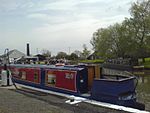Norbury, Staffordshire
Borough of StaffordCivil parishes in StaffordshireStaffordshire geography stubsVillages in Staffordshire

Norbury is a village and civil parish in the Borough of Stafford, in west Staffordshire, England. The population as taken at the 2011 census was 371. It is situated close to the Shropshire border, approximately 4 miles (6.4 km) north-east of Newport, just south of the A519 Newport to Newcastle-under-Lyme road, and two miles south-east of Woodseaves.
Excerpt from the Wikipedia article Norbury, Staffordshire (License: CC BY-SA 3.0, Authors, Images).Norbury, Staffordshire
Geographical coordinates (GPS) Address Nearby Places Show on map
Geographical coordinates (GPS)
| Latitude | Longitude |
|---|---|
| N 52.808 ° | E -2.321 ° |
Address
ST20 0PB
England, United Kingdom
Open on Google Maps








